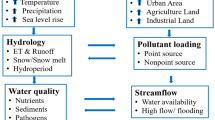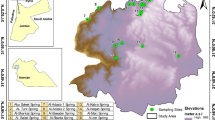Abstract
This paper addresses the relationship between the geology, hydrology, and transient variations in discharge and water chemistry of acidic water discharged by an abandoned underground coal mine: the Majestic Mine in Athens County, Ohio, a partially-flooded, downdip, drift mine. The Middle Kittanning (No. 6) Coal (Allegheny Series, Pennsylvanian System) was mined room-and-pillar until 1921. Loss of support from mine collapse has created large vertical subsidence fractures along the naturally occurring joints within the brittle sandstone overburden. The mine discharge hydrograph, temperature, and pH of the mine discharge indicate that the hydrology of the Majestic Mine can be explained in terms of pseudokarst hydrology. During rainfall events, water is preferentially recharged through the subsidence features. Increased pressure from the mine inflow is transmitted through the flooded workings, causing a rapid increase in discharge, and forcing older mine water out of the mine. A stream draining an overlying watershed is captured by one of the subsidence features, contributing 60 to 80% of the mine water outflow. During the summer, recharge to the mine is negligible because potential evapotranspiration is higher than precipitation. During late summer and fall months, when the mine pool is at its lowest elevation, atmospheric oxygen penetrates back into the mine workings, enhancing the oxidation reactions. During the increased discharge of the spring months, washing of the reaction products from the mine walls produces the highest metals concentrations and chemical loads. *** DIRECT SUPPORT *** A03BX002 00004
Similar content being viewed by others

References
Bogli, A. 1980. Karst Hydrology and Physical Speleology. Springer-Verlag, Berlin, Germany, 280 pp.
Brant, R.A. and E.Q. Moulton, 1960. Acid Mine Drainage Manual. Engineering Experiment Station Bulletin, The Ohio State University, 24 pp.
Friel, E.A., T.A. Ehlke, W.A. Hobba, Jr., S.M. Ward and R.A. Shultz, 1984. Hydrology of area 8, eastern coal province, West Virginia and Ohio. United States Geological Survey Open File Report 84-463, 77 pp.
Institute for Local Government and Rural Development, 1996. Ohio University. Unpublished map of underground coal mines within the Monday Creek Watershed.
Jennings, J.N. 1985. Karst Geomorphology. Basil Blackwell, Inc., Oxford, U.K., 293 pp.
Johnson, C.A., and I. Thornton. 1987. Hydrological and chemical factors controlling the concentrations of Fe, Cu, Zn, and As in a river system contaminated by acid mine drainage.Water Resources, 21: 359–365.
Moebs, N.N. and M.L. Clar, 1990. Feasibility of water diversion and overburden dewatering. U.S. Bureau of Mines Information Circular 9024, 68 pp.
Ohio Geological Survey, 1987. Abandoned Underground Mine Map: Nelsonville Quadrangle.
Ohio Geological Survey, Undated. Structure contour map of the Middle Kittanning (No. 6) Coal, 15-minute Athens Quadrangle.
Schmidt, R.D. 1989. Fracture zone dewatering to control ground water inflow in underground coal mines. Bureau of Mines Report of Investigation 8981, 34 pp.
Schultz, E.F. 1978. Problems in Applied Hydrology. Water Resources Publications, Littleton, Colorado, 501 pp.
Seaber, P.R., 1988. In: W. Back, J.S. Rosenshein and P.R. Seaber (Editors), Hydrogeology, The Geology of North America v. O-2, Geological Society of America, Boulder, Colorado: 189–200.
Smith, E.E., and K.S. Shumate, 1971. Rate of pyrite oxidation and acid production rate in the field. In: Proceedings of Acid Mine Drainage Workshop, Ohio University, Athens, Ohio, August 2–6: 11–18.
Sturgeon, M.T. and Associates. 1958. The geology and mineral resources of Athens County, Ohio. Ohio Geological Survey Bulletin 57, 600 pp.
Thornthwaite, C.W. and J.R. Mather. 1957. Instructions and tables for computing potential evapotranspiration and water balance. Laboratory of Climatology, Centerton, New Jersey, Publication 10: 185–311.
Ver Steeg, K. 1944. Some structural features of Ohio.Journal of Geology 52: 131–138.
Wikle, M. 1996. Personal communication. United States Forest Service, Athens, Ohio.
Author information
Authors and Affiliations
Rights and permissions
About this article
Cite this article
Pigati, E., López, D.L. Effect of subsidence on recharge at abandoned coal mines generating acidic drainage: The Majestic Mine, Athens County, Ohio. Mine Water and the Environment 18, 45–66 (1999). https://doi.org/10.1007/BF02687249
Issue Date:
DOI: https://doi.org/10.1007/BF02687249



